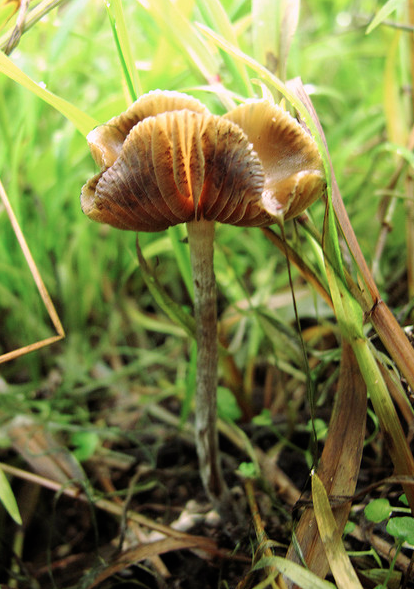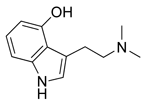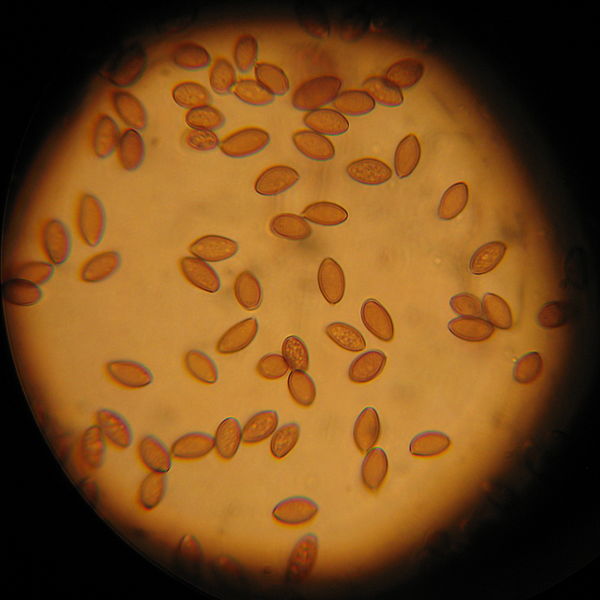Adaptations
An organism can undergo adaptations, which increase its
potential for survival to its environment. Adaptations, which
are the result of evolution, occur in every organism that has
ever lived! There are multiple adaptations that P.
cyanescens has undergone, so let's take a look at what has
occurred.
To
be able to
understand and garner appreciation for the adaptations of "The
Potent Psilocybe" you
need to understand its morphological structure.

Fungi are not
able to move or change locations in order to defend
themselves, therefore a different type of defense is necessary in
order to deter predation and guarantee reproductive success through
evolutionary changes in morphology. The most prominent adaptation
that Psilocybe cyanescens
has developed is its incorporation of two different psychoactive
compounds, psilocybin and psilocin, which can be toxic to some
predators that attempt to consume them. After predators ingest the
psilocybin compound found in the mushroom fruiting body the alkaline
phosphates are digested through the bodily functions of predators,
which leave a hydroxyl compound form known as psilocin. This is the
chemical that causes the hallucinogenic effects that
Psilocybe is known for.
Flickr Creative Commons, 2009
DETERRING PREDATION:
Psilocybe cyanescens is rooted in one permanent location,
therefore creating a necessary defense system is paramount to avoid
immense predation. The fungus has been able to develop a prominent
defense mechanisms in the form of two compounds. These compounds
will affect various organisms differently, including humans.
The
psilocybin compound can aid humans to some extent, by

alleviating symptoms of depression in the proper dosage. However,
other organisms can have more severe reactions to the compound,
which inevitably deter the organism from consuming the fungus in the
future. When predatory insects inject the compound, it paralyzes
their nervous system, which results in the death of the organism.
The compound is seen to the right, and is an alkaline phosphate
group that gets broken down in the body, into the simpler form
psilocin, which has hallucinogenic properties.
Wikimedia Commons, Jan 9, 2006
The
hydroxyl compound psilocin is the potent aspect of the
defensemechanism that the genus
Psilocybe has developed
through evolutionary practices, and also
serves as themain reason mammalian organisms actively seek out the
fungus. Once the compound has entered the body it can produce a
varying degree of effects, including nausea, stomach cramps, and
vivid hallucinations when consumed in a high enough dosage. This is
not necessarily completely
negative however, as the effects of the compound can
alleviate symptoms of chronic depression and help increase in
satisfaction, caused by the sense of "loss of reality" that many
organisms in the kingdom Animalia experience
when consuming the compound.
Wikimedia Commons, Oct 3, 2010
Therefore, it is necessary to discuss the implications that this can
have overall, as the mushroom is still sought after by a small
population. The compound known as psilocin is shown to the right,
and is a hydroxyl group that is digested through bodily processes.
Although it can be toxic in some cases, overall it is safe to
consume in moderation for human use without producing any negative
side effects at all.
OTHER FACINATING ADAPTATIONS
Along with the other species in the order Agaricales, P. cyanescens has developed gills on the bottom of the mushroom cap. As I mentioned previously, this allows for an exponentially increased surface area for the mushroom cap, which can then create millions of basidiospores to stimulate the growth of other mushrooms in the future.
The gills for the mushroom are incredibly interesting because

they have the potential to position themselves sothey are
always parallel to gravity. Therefore, as the mushroom begins
to lean in any direction, as a result of an elongated stem, the
gills are still able to release the basidiospores into the external
environment. If P. cyanescens did not possess this
adaptation,
the spores would not be able to release effectively. This would
result in basiospores ending up lodged into other gills, thus
limiting the potential for reproduction in the future. Thankfully,
P. cyanescens has been able to circumvent this issue, and
therefore the spores are able to be carried by the wind to
reproduce at extraordinary capacity.
Wikimedia Commons,
Dec 14, 2007
The most fascinating adaptation that has evolved occurs throughout the entire fungi kingdom. This would be the adaptation in which the mushrooms are able to produce an exoenzyme, which actually digests material before ingesting it. After the organic substance is completely digested, then the fungus is able to ingest it, and receive the adequate nutrients to survive. This adaptation permits fungus to consume a larger variety and quantity of organic substance, when compared to other kingdoms' potential to consume. This in turn permits fungi to consume a larger variety of substance, and in turn thrive in habitats that other organisms wouldn't be able to survive in. To view the complete lifecycle of P. Cyanescens see the life cycle page!
To see what P. Cyanescens consume, view my page on Nutrition!
